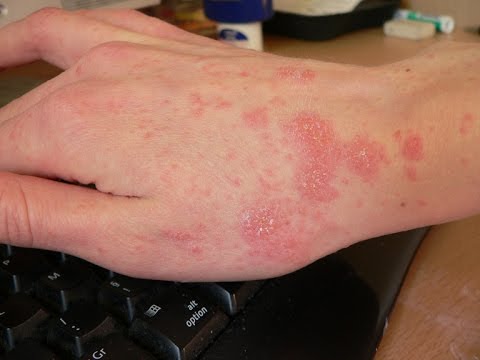Scabies is the most common skin disease encountered in some parts of the world, and is usually associated with poor living conditions. It is due to infection of the skin by the miteSarcoptes scabiei. Hyperinfections with crusting and pustulation are termed “Norwegian” scabies Scabies should be considered in every patient who complain, of a persistent itch, and this symptom, together with papules, vesicles, and pustules on the extremities and follicular papules on the trunk, should he regarded as being due to scabies.
The female mite is acquired by sharing a bed with an infected person or by other close personal contact, and in this sense in adults it can he likened to a venereal disease, The mite burrows into cracked and folded regions of the skin, the tunnel being limited to the stratum corneum except at the anterior end Burrowing is by means of jaws and the sharp cutting edges on the terminal joints of the first two pairs of legs.
Both copulation and egg production occur in the burrow, the rarely seen male ranging over the skin in search of the female About two eggs are produced daily for two months. The hatched six-legged larvae make their own burrows and develop into adulthood in a fortnight About one month after the establishment of the first burrow the patient begins to itch, probably because he becomes sensitized to acarine products.
The scratching limits the population of mites by depriving them of a roof over their heads and crushing them. In experimentally induced infections Mellanbv found that the population reached a maximum within three months and varied from 20 to 400 egg-laying females Examination of nearly 900 men with scabies showed a mean population of 11.3 adult females per man, and more than half the patients harbored five adult acan or fewer.
The skin eruption has two aspects: the burrows which have to he Kcarched for. and the changes resulting from sensitization and secondary infection which are obviouH. The burrow of the ovigerous female appears as a narrow, slightly raised white gray or black line. The white shiny dot sometimes seen at one end, which may Ik* associated with a small vesicle, is the site of the mite.
The burrou-h are commonly found on the sides and webs of the fingers, the ulnar border of the hand, the volar aspect of the wrists, the points of the elbows, the axillary folds, the areolae of the nipples in women, the external genitalia in men. the buttocks, and the margins or soles Of the feet. The face and scalp are never affected in adults Sometimes a typical burrow cannot be found. Therv is a widespread rash of follicular papules usually well marked on the abdomen, buttocks, inner sides of the thighs, and axillary folds. Scratch marks, crusted papules. and pustulation demonstrate the effects of scratching. An infected eczema sometimes develops on the fingers and wrists, nipples, or glans penis. Patients who are unable to scratch do not develop such lesions.
The diagnosis of scabies is probable if other members of the household are found infected. The mite can be identified by scraping a burrow along its length with the edge of a scalpel blade held at a right angle to the skin. The resultant material is mounted in 10 per cent potassium hydroxide under a coverslip. and microscopy reveals the mite. It has a body shaped like a tortoise with two pairs of legs in front and two pairs behind. The forelegs end in “suckers” and the hindlegs in long bristles. The female is about 400 fx long and coated in short bnstles. Eggs or immature forms may also be present.
The typical clinical picture of scabies is subject to a number of variations. In babies the scalp may be affected. which means that the topical preparation must be carefully applied Clean people usually have few lesions, and scabies may he overlooked in nurses for this reason. A localized eczema may be the presentation, or persistent sep>is of the skin The amount of itch is very variable In Norwegian scabies two million mites may be present, and the stratum corneum may be honeycombed with burrow* on biopsy. Clinically, Norwegian scabies memble* exfoliative dermatitis Often itching is alwent, and this has been offered as the explanation of this hvperinfcctive state However, some of these patients do itch, and other hypotheses attribute this slate to topical or systemic corticosteroids or vitamin A deficiency.
Treatment of scabies
The treatment of scabies is short and effective. It can be topical or orally and always supervised by a doctor.The treatment must be done in the whole group of cohabitants simultaneously to avoid the recurrence of infection.In addition, you should wash your underwear, towels and pajamas with hot water. Clothing that can not be washed should be placed in a closed plastic bag for a period of 2 weeks.
It is very important to keep the medicated lotion out of the reach of children, as it is toxic if swallowed.The itching may continue for two weeks or more after the treatment has started, but it will disappear if it has been performed properly.The treatment of scabies is short and effective. It can be topical or orally and always supervised by a doctor.
The treatment must be done in the whole group of cohabitants simultaneously to avoid the recurrence of infection.In addition, you should wash your underwear, towels and pajamas with hot water. Clothing that can not be washed should be placed in a closed plastic bag for a period of 2 weeks.
It is very important to keep the medicated lotion out of the reach of children, as it is toxic if swallowed.
The itching may continue for two weeks or more after the treatment has started, but it will disappear if it has been performed properly.
